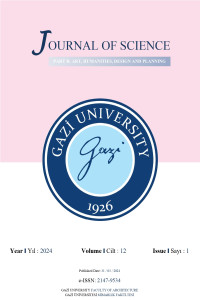Öz
Kaynakça
- [1] Dewey, J. (2023a). Deneyim ve eğitim (6. Press). (S. Akıllı, Trans.). ODTÜ Yayıncılık (Original work published 1938)
- [2] Tandoğan, O. (2011). İstanbul’da çocuk dostu kent için açık alanların planlama, tasarım ve yönetim ilkelerinin oluşturulması. [PhD, İstanbul Teknik Üniversitesi]. YÖK Ulusal Tez Merkezi. https://tez.yok.gov.tr/UlusalTezMerkezi/tezDetay.jsp?id=x0d1V8yRRNCpb394Tq0x0w&no=sbv151HXnShe0U0AhOZaWA
- [3] IPA International Play Association. (2014). Declaration on the importance of play. https://ipaworld.org/childs-right-to-play/the-childs-right-to-play/ in 02.04.2023
- [4] Ward, C. (1977). The child in the city. The Architectural Press
- [5] Dattner, R. (1974). Design for play. The MIT Press.
- [6] Frost. J. L. (2010). A history of children's play and play environments: Toward a contemporary child-saving movement. Taylor and Francis. https://doi.org/10.4324/9780203868652.
- [7] Bengtsson, A. (1979). Children's play is more than physical education. In Zaghloul Morsy (Ed.), Prospects Quarterly Review of Education (pp.450-457). Imprimerie des Presses Universitaires de France. https://unesdoc.unesco.org/ark:/48223/pf0000036403
- [8] Little, H., & Eager, D. (2010). Risk, challenge and safety: Implications for play quality and playground design. European Early Childhood Education Research Journal, 18(4), 497-513.
- [9] Özmakas, U. & Yıldırım, K. (2020). Dışlayıcı mimari. Mülkiye Dergisi, 44(4), 775-794.
- [10] Dewey, J. (1966). The child and the curriculum including, the school and society. The University of Chicago Press Chicago & London.
READING THE RELATIONSHIP OF CHILDREN’S PLAYGROUNDS WITH DISCIPLINARY ARCHITECTURE THROUGH JOHN DEWEY’S EDUCATIONAL STRATEGIES
Öz
Playgrounds, included in a child's education and daily life, appear as places that, with their spatial configuration, affect the child's play experience, current teachings, and future references, thus his internal education and external freedom of movement. 21st-century playgrounds, defined enough to influence thinking or exploration, are a "disciplinary" socio-spatial problem that reinforces boundaries for children. The hypothesis of this study is that space design has disciplinary effects on the child's experience. In the study, which approaches Dewey's educational strategies and active learning methods in search of improvement, firstly, the implicit disciplinary aspects of playgrounds were identified. During the second stage, Dewey's educational strategies were examined. Finally, the focus was on "adventure playgrounds" that overlapped with Dewey's educational strategies. Riis Park Plaza and Adventure Playground, which were among the sixteen adventure playgrounds implemented in America until 1977, were determined as the sample for the study. These two areas were examined using a case study, one of the qualitative research methods. As a result of the investigations, it has been understood that playgrounds that avoid limited design criteria have the potential to activate the child's sense of curiosity, positively affect the quality of the experience, and increase the level of external freedom.
Anahtar Kelimeler
Child Experience Playgrounds Disciplinary architecture. Dewey's educational strategies
Kaynakça
- [1] Dewey, J. (2023a). Deneyim ve eğitim (6. Press). (S. Akıllı, Trans.). ODTÜ Yayıncılık (Original work published 1938)
- [2] Tandoğan, O. (2011). İstanbul’da çocuk dostu kent için açık alanların planlama, tasarım ve yönetim ilkelerinin oluşturulması. [PhD, İstanbul Teknik Üniversitesi]. YÖK Ulusal Tez Merkezi. https://tez.yok.gov.tr/UlusalTezMerkezi/tezDetay.jsp?id=x0d1V8yRRNCpb394Tq0x0w&no=sbv151HXnShe0U0AhOZaWA
- [3] IPA International Play Association. (2014). Declaration on the importance of play. https://ipaworld.org/childs-right-to-play/the-childs-right-to-play/ in 02.04.2023
- [4] Ward, C. (1977). The child in the city. The Architectural Press
- [5] Dattner, R. (1974). Design for play. The MIT Press.
- [6] Frost. J. L. (2010). A history of children's play and play environments: Toward a contemporary child-saving movement. Taylor and Francis. https://doi.org/10.4324/9780203868652.
- [7] Bengtsson, A. (1979). Children's play is more than physical education. In Zaghloul Morsy (Ed.), Prospects Quarterly Review of Education (pp.450-457). Imprimerie des Presses Universitaires de France. https://unesdoc.unesco.org/ark:/48223/pf0000036403
- [8] Little, H., & Eager, D. (2010). Risk, challenge and safety: Implications for play quality and playground design. European Early Childhood Education Research Journal, 18(4), 497-513.
- [9] Özmakas, U. & Yıldırım, K. (2020). Dışlayıcı mimari. Mülkiye Dergisi, 44(4), 775-794.
- [10] Dewey, J. (1966). The child and the curriculum including, the school and society. The University of Chicago Press Chicago & London.
Ayrıntılar
| Birincil Dil | İngilizce |
|---|---|
| Konular | Etkileşim ve Deneyim Tasarımı |
| Bölüm | Mimarlık |
| Yazarlar | |
| Yayımlanma Tarihi | 31 Mart 2024 |
| Gönderilme Tarihi | 3 Mart 2024 |
| Kabul Tarihi | 26 Mart 2024 |
| Yayımlandığı Sayı | Yıl 2024 Cilt: 12 Sayı: 1 |

